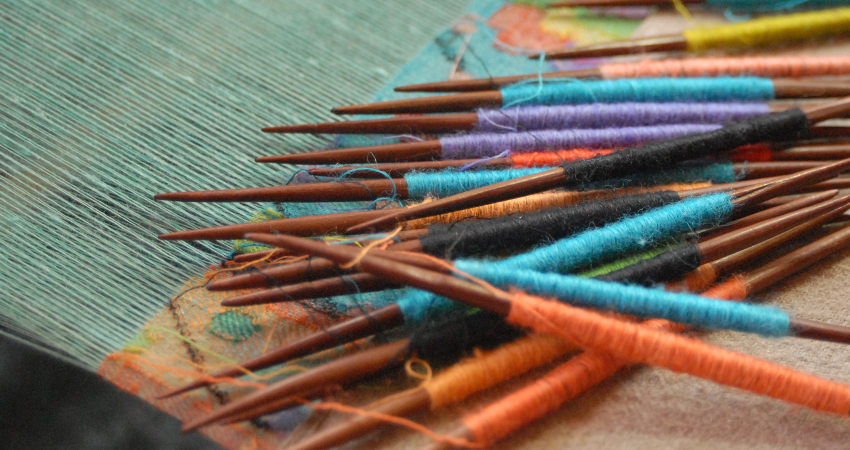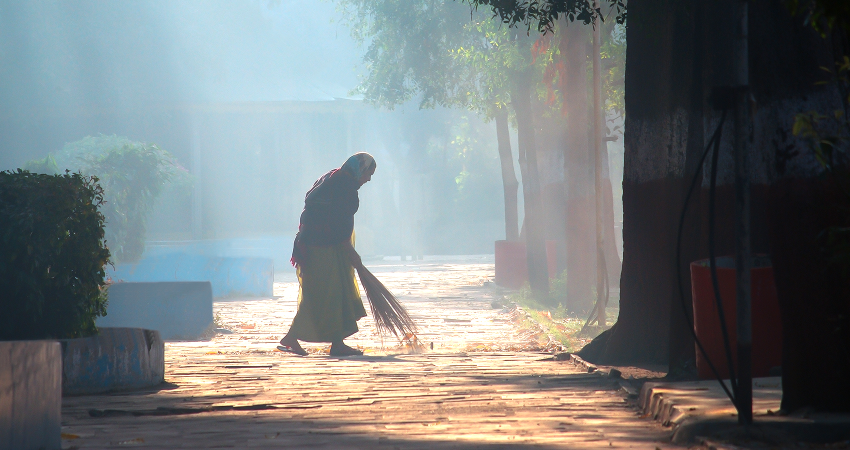
Plastic ban: An opportunity to encourage ecological and economic growth
The need of eco-friendly products has never been so important than today when plastic has already choked our cities, oceans, and mountains. This year on World Environment Day, the entire world took a pledge to ‘Beat Plastic Pollution’ to combat one of the great environmental challenges that our generation is facing. Continuing the resolution, Maharashtra, and Uttar Pradesh states banned the use of plastics in July while Odisha government has planned to implement the rule from October month. This comprehensive plastic ban also includes disposable cups and plates, cutlery, and packaging. Hence, the products made of natural resources like leaf, coconut, and wood have caught the attention of everyone these days.
Plastic waste has become a major concern in urban areas and people now are looking for options to replace the plastic cutlery with recyclable products. This rising demand of eco-friendly products has created entrepreneurship opportunities for people in rural and semi-urban areas. To boost small enterprises, many corporates and NGOs are also providing technology and skill development programs that help people in their entrepreneurial journey and build a community of rural entrepreneurs. New Delhi based NGO, ‘Dhriiti – The Courage Within’ is working towards its mission of transforming communities by developing entrepreneurial skills in people from diverse socio economic backgrounds.
Dhriiti works with entrepreneurs who identify and convert opportunity into sustainable enterprises to enhance the quality of livelihood. The organization nurtures, incubates, and support potential entrepreneurs through its innovative and professional approach. It endeavors to promote entrepreneurship in different forms and build a spirit of entrepreneurship amongst the communities. With its ‘Financial, Social, Ecological (FSE)’ concept, Dhriiti works with aspiring entrepreneurs who can build transformative enterprises to protect the environment and bring a positive change in the society.
The organization understands that rural areas have great potential but people face challenges like limited access to finance, gaps in skills, unfavorable business environment; low financial sustainability, and lack of planning. Dhriiti team aims to meet such challenges and promote small industries by applying modern management and technology tools. The organization is running various skill development and entrepreneurship projects with support from corporates and state governments. As a part of its endeavor for North East India, it has been working on ‘Arecanut Leaf Plate Manufacturing Cluster Development Project’ in Assam.
More than 500 micro enterprise units have been set up under this project to make disposable plates and bowls from the sheath of arecanut trees. Till date, the project has trained more than 5000 people and has engaged 7000 families in North East India. The enterprise has created a positive impact on region’s employability percentage as each unit provides employment to more than 20 rural youths. ‘Tamul Plate Marketing Pvt. Ltd. (TPMPL)’, an institution created under this initiative manages the whole operations in a commercially sustainable manner.
Today, TPMPL markets the high quality products at national and international level under the brand name, Arecana. The project has been the most successful program wherein Dhriiti nurtured the entire project for 10 years and handed over operations to the producers’ institution. Going forward, the program has a vision to build a micro enterprise value chain worth INR 100 crores in North East by 2020.
Additionally, to further push the growth of eco-friendly industries, Dhriiti is working on its ‘Sal and Siali Leaf Plate Cluster Development’ project supported by Odisha Forestry Sector Development Project (OFSDP), Government of Odisha. The project is aimed towards the development of innovative product designs for high end urban areas as well as the international market. The project aims to become a people’s institution in next five years boosting the Sal and Siali leaf plate manufacturing in the state. Dhriiti team will be working with Sal leaf plate producers in two blocks of Keonjhar and Rourkela. The project will be amplified further as a full cluster development program in partnership with various public and private bodies.
Needless to say that making eco-friendly product from leaf and other natural sources not only supports the underprivileged community but also helps in saving environment and reducing wastage. As the plastic is badly affecting our health and surroundings, the use of eco-friendly products has become more like a necessity than a choice. By adopting sustainable habits and promoting eco-entrepreneurship, we can surely give a gift of health and happiness to our next generation.

Paper Works !!!
In a candid chat with Pooja Sriram, owner, Orange Peel, she tells us how social networking and word of mouth are some simple yet creative promotional strategies for business ventures.
Pooja, a 26 year old entrepreneur always had an eye for things unique and creative! “Orange Peel, is one of those creative ideas that actually progressed from an idea to a product and now a business.” Orange Peel is like her in-house creative incubator where, she with her mother and sister, creates beautiful jewellery mostly earrings for now, made from paper in vibrant colours.
“Orange Peel was born in March 2013, just like a hobby. With more people appreciating our work, we decided to name our brand. Before we knew it, we had a logo, a full-fledged Facebook page and several ‘likes’ pouring in! Orange Peel is that little nut-shell that has integrated my love for colour, creativity and social networking.”
Orange Peel also offers Pooja a canvas to bring forth her photography skills as well as marketing tactics. Her large network of friends and acquaintances are now her customers and sure her teachers are proud to see her put the knowledge imparted to use.
What inspired you?
The idea was a pure result of a visit to the many Santes and flea markets that are held in Bangalore. The idea of making paper jewellery is not new; but our products are 100% handmade and the efforts put in to come up with new designs, unique colour schemes, and attention to detail, make us different from the rest. And for the sourcing of material, I am thankful for Mom’s bargaining skills that make the procurement of materials an easy task!
Who are your target customers?
As of now Orange Peel only has paper jewellery which makes women our target customers. We have girls as young as 4 to women as old as 60 buying our products. However, we also have some adorable men buying these as gifts for their wives, girlfriends, daughters and moms! We have plans of expanding our portfolio with hair accessories, key chains, magnets, home décor products, etc and hope to have a more diverse group of customers.
What is the marketing model that you follow?
Orange Peel started just 3 months ago and all our marketing is through word of mouth and the god of all social networking sites – Facebook. Using our own PR skills and Social network Orange Peel has had more than 200 likes in 2 months and the page had more than 3000 views! One strategy that worked for us was to get single boys to buy or promote Orange Peel products with all the girls at their workplace.
How do your customers get the products since these are small goods purchased online?
I like meeting my customers. I either get them to pick it up from my homes, we work from both my Mom’s and Mother in Law’s place, or I meet them and deliver it to them. In case of orders overseas, I have got relatives and friends travelling to deliver my little packets. With our orders increasing, we will soon start couriering them.
About the Author: Pooja Sriram pursued her MBA in Advertising & Marketing Communication from the Manipal Institute of Media and Entertainment (MIME) and is currently an Associate Manager- Product Marketing at a Global Mobile VAS organisation- Onmobile Global Ltd. Orange Peel products range from Rs.29-Rs.149. Check them out at www.facebook.com/orangepeelswirlart

The Cashmere Touch of the Pashmina
Most of us who are able to look beyond the insurgency in Kashmir view it as a place with immense natural beauty – a land of stunning lakes and mountains! Nothing epitomizes the glorious history of the Himalayan craftsmanship, as warmly and beautifully as does the Pashmina. Pashmina, prized by kings and nobles and the pride of a bride’s trousseau even now, is often referred to as the ‘diamond’ of all fibres. The artisans of Srinagar narrate the stories of their forefathers who served the Mughals and made a single shawl in a 6-12 month period. Even today their fine art exists and some shawls take months to be completed.
The splendid craftsmanship
Pashmina mainly comes from the Himalayan region and is known for its warmth and long life. The uniquely soft fleece is hand-combed every spring from the soft wool from the neck and chest of the Capra Hircus, the Himalayan mountain goat. These goats are reared in herds at altitudes over 14000 feet in the arid plateaux of Ladakh, Tibet and Mongolia. The thermo conductivity of the wool is one of the best in the world as it survives the animal at -40 degree centigrade in virgin pollution-free climates of the world. Pashmina fibre is 12.5 – 19 microns in thickness (1/6th the size of human hair which is 75 microns thick) making it supremely soft.
Spinning the yarn
The production of Pashmina shawls in Kashmir is more or less concentrated in Srinagar. Even the raw material traders, small and big manufacturers are situated in Srinagar. The hand spun Pashmina yarn goes through various stages of dyeing, sizing, warp preparation and finally the actual weaving before the wondrous transformation from the unruly mass of fibre to a textile of unique softness, warmth and beauty can be seen. Even after weaving the unique process of tweezing, clipping and washing in the waters of Jhelum gives the Pashmina shawl its royal touch. Due to the requirement of high quality skills in each process the production involves many artisans. Thus the production process is fragmented into various sub-processes. Each type of artisan does their work and then the material is passed on to the next category. The production is controlled by the manufacturers who invest their capital. Earlier the raw material-end till the manufacturing of yarn was controlled by Poiwanis (Raw material dealer) and the finished product-end was controlled by the big manufacturers. But this division has become blurred today as many Poiwanis are into complete manufacturing and the big manufacturers also deal in raw material.
Amongst the artisans the spinners are the largest group, constituting 65-75% of the total number of artisans. The spinning is done completely by women and is one of the most difficult tasks in the value chain. The cleaning and de-hairing of raw pashmina was also earlier done by the spinners but today it has been fully mechanised. The weavers are the next largest in numbers and represent 15-20% of the artisans. The weavers are generally more knowledgeable and enterprising than the other kinds of artisans. Thus many of them graduate from weavers to small manufacturers. Embroiderers are the third in hierarchy of artisans. The present structure of production is described through the diagram below:
The weave
All hand-woven Pashmina fabrics are traditionally woven in the twill weave, with different permutations of it. This can be classified into three categories:
- Saadi – a simple and un-patterned hand-woven fabric employing a four shaft twill weave and various combinations
- Kani- a highly decorative brocade textile, made on exactly the same loom as the one used for plain Pashmina fabric, but with woven patterns
- Amlikar- usually a plain Pashmina, embroidered upon with very fine Kashmir mulberry silk, Pashmina or cotton thread
It takes the wool from four and over 200 man-hours (spinning, weaving, dying and decorating, finishing) to make just one pashmina shawl. Hand cleaning and spinning the wool for a single Pashmina takes 15 days, so naturally the labour-intensive production is reflected in the price. An original Kashmiri handmade Pashmina may cost between Rs.5,000 and Rs.1,00,000 depending on the level of craftsmanship. Though the craft is under threat from various spurious shawls in market which are sold in the name of Pashmina at cheap prices, the thousands of artisans have maintained their tradition since ages and should be able to protect it even in this globalised world. The artisans in Kashmir say that Pashmina is Pashmina not because of the material but because of the process. Thus one has to visit the bye-lanes of Srinagar to experience the magic of Pashmina.
About the author: Arindam Dasgupta, is the CEO of Tambul Plates Marketing Pvt. Ltd. and is an expert in micro enterprise development. He is currently based out of Barpeta, Assam

The Broom Broom Enterprise
Ever wondered how and where, one of the most essential cleaning equipment in all Indian households, the broomstick, is made? These were a few questions that intrigued me to discover an entrepreneurial potential in Meghalaya in the North-east of India. And at once I decided to travel to the picturesque state with vast expanse of broom grass plantations.
Where?
Meghalaya is home to a population of 2,306,069 inhabitants (census 2001) with about 5780 villages. The people in Meghalaya find their source of livelihood in agriculture and allied activities. The broom plant is a major forest-based resource for the farmers here and is distributed widely throughout the state of Meghalaya. It is commonly found on the hills, damp steep banks along ravines and on sandy banks of the rivers.
Set in a hilly landscape, Meghalaya is divided into 7 districts – East Khasi Hills, West Khasi Hills, East Garo Hills, West Garo Hills, South Garo Hills, Ri Bhoi, and Jaintia Hills. The biggest advantage for the farmers in Meghalaya is the cultivation of broom-grass which is easy and requires less financial investment.
How?
The broom grass can be grown even on marginal lands, wastelands and jhum fallow. Its cultivation can promote the sustainable use of fragile and degraded lands. It grows well on a wide range of soils varying from sandy loam to clay loam. The planting can be done by seeds or rhizomes. Some people also collect and transplant the wild seedlings for propagation. However, it is considered better to get quality seedlings from reputed nurseries.
The culms arise centrifugally during the peak growing season (April to July) and bear inflorescence (panicle) on shoot apex at the end of vegetative growth. The inflorescence that is about 30 to 90 cm long resembles a fox-tail and is used as broom. And this is sold as broomsticks!
Trade & retail
However, more than the botanical bit, what I really wanted to know was how the brooms ultimately reach its users. Do traders go to Meghalaya and buy it from farmers? What is the mechanism involved? How is the pricing done? With the rest of the economy, has this industry also grown by leaps and bounds? What is the life of people involved in this trade like? Is there an entrepreneurial spirit within them that constantly pushes them towards the better?
I got in touch with Bhaskar who runs ‘The Bhaskar Broom Company – Bamfoi’, about 50 km away from Guwahati. “Our Company collects brooms and takes them to Guwahati. There we sell them to the traders. After that it is those traders who supply it to the end users.” He also mentioned how the market for brooms is largely confined to northern India, mostly cities like Delhi, Mumbai and Kolkata.
Broom grass grown in the hills is made available to traders in a nursery at Karbi Anglong district of Assam, which are sent to Guwahati by small companies. Usually traders purchase the produce only between February-April. A bundle of 1 kilogram of broomsticks contains about 3-4 sticks and costs Rs.20-22. In the off season, the same is sold for Rs.30-40. To the small and marginalized farmers broom cultivation is an economic activity that sustains their seasonal livelihoods.
Marketing broom grass is easy since Meghalaya offers a vast linkage of all the villages to the wider regional or national market through their local market. In the months of December, January and February these local markets are flooded with broom sticks and the middlemen are the potential buyers. Earlier there used to be no fixed price and it was dependent completely on the price quoted by the middlemen. Now that the market has developed, a stronger framework is used.
“We take the grass from here and get them tied into brooms in Shillong. After that they go to households all over the country” says, a trader. Thus, value-addition of binding tufts of broomstick into an easily usable broom for sweeping floors and dusting ceilings, etc happens elsewhere.
Leading to national growth
Activities such as cultivation of broom grass on a large scale, if promoted not only help in regional development and providing employment but also contribute to the national growth on the whole. Although the cultivation of Thysanolaena maxima (broom grass) is largely unorganized, it grows in the wild on the hillsides, traders confidently make the sweeping statement that Meghalaya is easily the jharu capital of India. Agrees P.S. Nongbri, a Shillong-based forest officer who had prepared a report in 1995 on broomstick production and how it could be improved.
Mizoram Forest Produce Marketing Agency (MIFMA) purchases broomsticks at Vairengte on the Mizoram-Assam border are in turn sold to Shree Shyam Trading Company, New Delhi and the North East Regional Marketing Corporation, Govt. of India Enterprise, Guwahati.
According to MIFMA, Rs.3 crores have already been used to purchase these broomsticks and some families have received incomes of up to Rs.3 lakhs from their sales.
Apart from the MIFMA, the major change that took place happened after the Meghalaya Forest Department took these brooms to international trade fairs – a trade fair in Delhi in 1994 received an overwhelming response! Country-wide enquiries came along and by the following year, the price of a quintal of broom grass shot up from Rs.1,100-Rs.3,000. Even though the middlemen take a huge part of this revenue, they get about 60% of the price even which fetches the average household Rs.6,000-Rs.7,000 a year as additional income. The Meghalaya government decided to promote the plantation of broom grass in 1995. The scheme, from all accounts, has met with great success.
Efforts from NABARD
Even on the banking and finance front, there have been commendable efforts. For instance, The National Bank for Agriculture & Rural Development (NABARD), the Apex level National Bank in the field of Agriculture & Rural Development established on 12 July 1982 announced some favourable policy initiatives for the North-East India especially Mizoram.
It went one step further with its SHG (Self-help group) linkage programme which involves linking such groups to the formal banking system by sanctioning Rs.10.90 lakh to NGOs and banks for promotion and credit linking of more number of SHGs in the days to come. 9 Farmers Clubs have so far been formed and assisted with active participation of NGOs and bankers in the State. Further, grant assistance aggregating to Rs.8.81 lakh was provided to various NGOs for conduct of 15 Skill Development Programmes in various activities. These included broom processing and broom-making in addition to other trades like candle-making, tailoring, jam & pickle making, jute & handicraft, bamboo basket weaving, etc. These programmes have benefited 393 participants to provide self-employment.
The farmers of the North-east, the traders and the middlemen are part of an industry that poses a huge business opportunity. It continues to define the lives of a large segment of India, as they learn to recognize its benefits not only for themselves and their customers, but for the environment as well.

